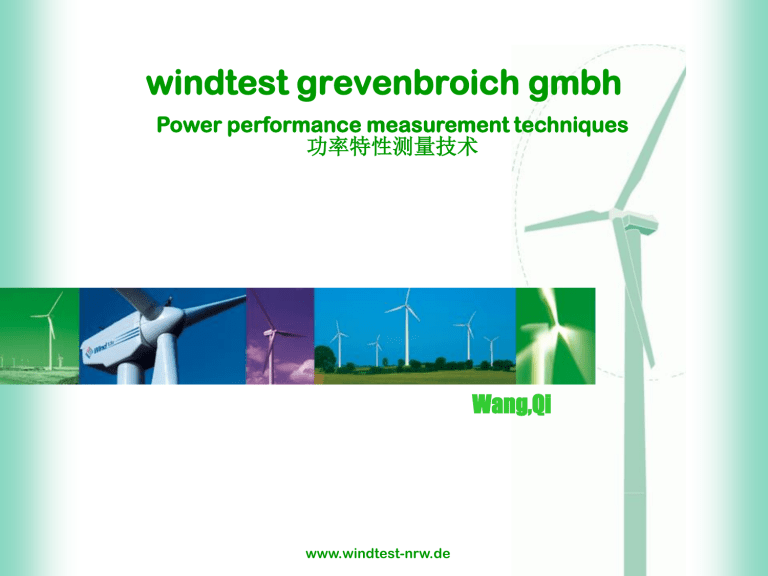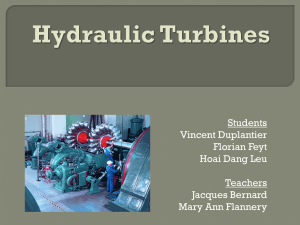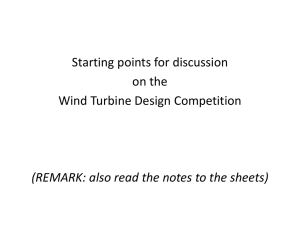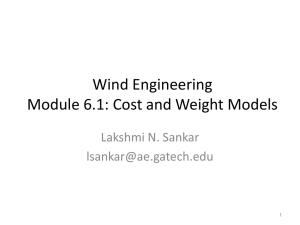Power Point - AlienScientist.com

windtest grevenbroich gmbh
Power performance measurement techniques
功率特性测量技术 www.windtest-nrw.de
Wang,Qi
Table of contents
• Introduction.
• Physics of the wind.
• Instrumentation.
• How it works.
• Measurements and measurement procedures.
• Evaluation of the power performance.
• Small wind turbines.
www.windtest-nrw.de
2
Introduction
• The acoustic noise measurement technique is based on the IEC 61400-12-1.
• The purpose is to ensure consistency, reproducibility and accuracy in measurement and analysis of power performance by wind turbine generator system.
• The standard provides guidance in the measurement, analysis and reporting of power performance testing.
• The key element of power performance testing is the measurement of wind speed .
www.windtest-nrw.de
3
Introduction
• Procedural overview.
Power
Performance
Measurement
NO
Site Calibration
According To Annex C
Test Site Assessment
If Fulfill Annex B
YES
Setup Test Equipment
Data Collection
Filter Data For:
- Wind Speed
- Wind Direction
- Turbine Online
- Failure Or Degration
Of Test Equipment www.windtest-nrw.de
Data Correction
Store Database
Finial Analysis:
- Power Curve
- AEP Calculation
- C Calculation
- Uncertanty
Assessment
Reporting And
Documentation
End Of Power
Performance
Measurement
4
Power of the wind
Volume
Density
Mass
Energy
Power
Mass Flow
V
A
dx
m
V
1 .
2 kg m
3 m
V
A
dx
E
Kin
1
2
m
v 2
P
E
t
1
2
dm
v
2 dt dm dt
A
dx dt
A
v v
A dx
P
1
2
A
v
3
V www.windtest-nrw.de
5
Extracted mechanical power P mech
P mech
P
1
P
3
1
2
A v
1 1
3
A v
3
3 3
Constant mass flow
v A
1
v
2
A
2
v
3
A
3
A
3
v
1
v
3
A
1
P mech
2
1
2 v
3
2
Maximum:
P mech max
P mech v
3
0
1
2
A
1
v
1
3 v
1
F
1 v
2
F
2
P mech v
3
F
3 www.windtest-nrw.de
6
Power coefficient c p
A
2
v
2
1
2
A
2
( v
1
v
3
) v
2
v
1
v
3
2
P mech
1
2
A
1
v
1
v
1
2 v
3
2
1
2
A
2
v
2
v
1
2 v
3
2
P mech
1
4
A
2
v
1
2
v
3
2
v
1
v
3
v
1
P v
3
0
1
2
A
2
v
1
3
F
1 v
2
F
2 c p
P mech
P
1
2
1
a
2
1
a
a
v
3 v
1
P mech www.windtest-nrw.de
v
3
F
3
7
Maximum power coefficient c p c p
1
2
( 1
a
2
)
( 1
a ) c p
1
2
( 1
a
a
2 a
3
) dc p da
1
2
( 1
2 a
3 a
2
)
1
2 a
3 a
2
0 a
v
3 v
1
1
3
Betz factor
Maximum v
1 c p max
16
27
0 .
593
59 , 3 %
F
1 dc p
0 da v
2
F
2
P mech www.windtest-nrw.de
v
3
F
3
8
Summary
Power of the wind
P
1
2
A
v
3
Extracted mechanical Power
Betz Factor
P mech
1
2
c p
A
v
3 c p max
0 .
593
59 , 3 %
Tip Speed Ratio
v tip v wind www.windtest-nrw.de
9
Power coefficient c p example www.windtest-nrw.de
10
Power coefficient c p example www.windtest-nrw.de
11
Instruments
• Electric power.
– Power transducer: shall fulfill IEC 60688 Class 0.5 or better.
– Not a power transducer: the accuracy should be equivalent to Class 0.5 power transducers.
– The full-scale range of measurement device should be set to -50% to +200% of the rated power.
• Anemometers.
–
Should use the class better than 1.7A.
– Should use the class better than 2.5B or 1.7S if site calibration requiring.
– The difference between the regression lines of calibration and recalibration shall be within ± 0.1 m/s in the range 6 m/s to 12 m/s.
– The cup anemometer shall be mounted at hub height of ± 2.5%.
www.windtest-nrw.de
12
Instruments
• Wind direction transducer.
– The combined calibration, operation, and orientation uncertainty shall be less than 5 ° .
• Air density.
– Shall be derived from the measurement of air temperature and pressure.
– At high temperature, it is recommended also that relative humidity be measured and corrected for.
–
Thermometer.
• Shall be mounted within 10 meter of hub height.
– Hygrometer.
– Barometer.
• Shall be corrected to the hub height according to ISO 2533.
www.windtest-nrw.de
13
Instruments
• Rotational speed and pitch angle.
– If specific need, i.e. measurements connection with acoustic noise tests.
• Blade condition.
– Particularly for stall regulated turbines.
– Precipitation, icing and bug etc.
• Data acquisition system (DAS).
– Sampling rate per channel of at least 1Hz shall be used.
www.windtest-nrw.de
14
How it works
• Wind speed measurement.
– The shaft of an anemometer is coupled to an electrical transducer which produces an electrical output signal, typically a DC voltage proportional to shaft rotation rate and therefore to wind speed.
Wind Speed Frequency
Cup
Shaft Rotation
Electrical transducer
– The wind speed can be calculated from the frequency in onlinefamos using equation:
V
W
a
0
a
f
V
W a
0
: Wind speed
: The regression coefficient [m/s] a : The regression coefficient [m/s/Hz].
f : Frequency www.windtest-nrw.de
15
How it works
• Wind speed measurement.
Pulse signal transformation www.windtest-nrw.de
16
How it works
• Wind direction measurement.
– When the wind blows past the vane, the change of wind direction is measured by the sensor as the aerodynamics of the counter-weight and the tail try to keep aligned to the path of the wind. The motion of the wind vane is translated to the potentiometer shaft causing a change in the potentiometer's resistance, as a change in voltage.
2K Ohm
Wind vane direction www.windtest-nrw.de
Potentiometer
17
How it works
• Temperature measurement.
– PT100 is a temperature-dependent resistance. It has
100 ohms with 0 ° C , the temperature coefficient amounts to depending upon platinum material +0.385 ohm/ ° C. The voltage drop at the platinum sensor rise with increasing temperature and concomitantly the difference at the instrument amplifier.
• Humidity measurement.
– The capacitive sensors sense water by applying an
AC signal between two plates and measuring the change in capacitance caused by the amount of water present. The resistive sensors use a polymer membrane which changes conductivity according to absorbed water.
www.windtest-nrw.de
18
How it works
• Temperature and humidity measurement.
Meteorological box
• Pressure measurement.
– PTB100 barometers feature the silicon capacitive absolute pressure sensor. The sensor have 0-5 VDC output and 800-
1060 mbar pressure range.
– The barometric pressure can be calculated from the measured output voltage using a simple equation:
P
800 mbar
260 mbar
U
5 V www.windtest-nrw.de
19
Measurements and measurement procedures
• Location of the meteorological mast and measurement sector.
– Shall be positioned at a distance from the wind turbine of between 2D and 4D of the wind turbine,
2.5D is recommended.
Distance of the meteorological mast and maximum allowed measurement sectors www.windtest-nrw.de
20
Measurements and measurement procedures
• Assessment of terrain at the test site.
–
If the terrain complies with the requirements of Table B.1, then no site calibration is required.
–
If wind speed different between the anemometer position and the turbine’s hub less than 1% at 10 m/s for the measurement sectors, then no site calibration is required.
Table B.1 Test site requirements: topographical variations www.windtest-nrw.de
21
Measurements and measurement procedures
• Measurement procedure.
–
General
• The measurement procedure shall be documented, as detailed in
Clause 9.
• Accuracy of the measurements shall be expressed as described in
Annex D.
• During the measurement period, data should be periodically checked, and the test logs shall be maintained to document all important events.
– Wind turbine operation.
• Shall be in normal operation and the machine configuration may not be changed.
• Any special maintenance actions during the test shall be noted.
www.windtest-nrw.de
22
Measurements and measurement procedures
• Measurement procedure.
–
Data collection.
• Selected data sets shall be base on 10-min periods derived from contiguous measured data.
• Data shall be collected continuously at a sampling rate of 1 Hz or higher.
• Air temperature, pressure, wind turbine status and precipitation may be sampled at a slower rate, but at least once per minute.
• The data shall store either sampled data or statistics of data sets as:
» Mean value.
» Standard deviation.
» Maximum value.
» Minimum value.
www.windtest-nrw.de
23
Measurements and measurement procedures
• Measurement procedure.
–
Data rejection.
• To ensure that only data obtained during normal operation are used in analysis and data are not corrupted. Data sets shall be excluded following circumstances:
» Wind speed are out of the operating range;
» Turbine fault, manually shutdown, in test or maintenance operating mode;
» Failure or degradation of test equipment;
» Wind directions outside valid sectors.
• To ensure that only data obtained during normal operation are used in analysis and data are not corrupted. Data sets shall be excluded following circumstances:
» Wind speed are out of the operating range;
» Turbine fault, manually shutdown, in test or maintenance operating mode;
» Failure or degradation of test equipment;
» Wind directions outside valid sectors.
• Two data sets shall be presented because the effect of hysteresis.
One shall include all data points (Database A), the other shall exclude the turbine has stopped generating power due to cut-out at high wind speed (Database B).
www.windtest-nrw.de
24
Measurements and measurement procedures
• Measurement procedure.
–
Data correction.
• Wind speed shall be corrected for flow distortion from site calibration.
• Air pressure shall be corrected if measured at 10 meter difference that closed to hub height.
–
Database.
• Filtered database shall include a minimum of 180 h of sampled data.
• Each bin shall include a minimum of 30 min of sampled data.
• The selected data sets shall at least cover a wind speed range extending from 1 m/s below cut-in to 1,5 times the wind speed at
85% of the rated power of the wind turbine.
• Alternatively, the wind speed range shall extend from 1m/s below cut-in to a wind speed at which " AEP -measured" is greater than or equal to 95% of " AEP -extrapolated" www.windtest-nrw.de
25
Evaluation of the power performance.
• AEP (annual energy production).
–
AEP is estimated by applying the measured power curve to different reference wind speed frequency distributions.
–
AEP shall be made for hub height annual average wind speed of 4, 5, 6, 7, 8, 9, 10 and 11 m/s according to :
AEP
N h
i
N
1
F
i i 1
P i
1
2
P i and F
1
exp
4
V
V ave
2
N h
N:
:
V i
P i
:
:
V ave
V:
:
F(V): number of hours in one year ≈8760 number of bins normalized and averaged wind speed in bin i normalized and averaged power output in bin i annual average wind speed at hub height wind speed the Rayleigh cumulative probability distribution function for wind speed www.windtest-nrw.de
26
Evaluation of the power performance.
• AEP (annual energy production).
V_annual, hub height
(Rayleigh)
6
7
8 m/s
4
5
9
10
11
AEP measured kWh
12624
24081
37427
50179
60341
67094
70599
71494
Reference air density
Cut out wind speed
AEP extrapolated
AEP extra / AEP meas.
kWh
12624
24099
37715
51705
64800
76246
85610
92697
1.225 kg/m³
25 m/s
%
100
100
101
103
107
114
121
130
AEP calculation www.windtest-nrw.de
27
Evaluation of the power performance.
• Measured power curve.
– Determined by “method of bins” for the normalized dataset.
– Using 0.5 m/s bins and calculation of the mean values of wind speed and power output for each bin according to:
V i
1
N i
V i
:
:
V n,i,j
P i
P n,i,j
N i
:
:
:
j
N
1
V n , i , j and
P i
1
N i
N j
1
P n , i , j normalized and averaged wind speed in bin i normalized wind speed of dataset j in bin i normalized and averaged power output in bin i normalized power output of dataset j in bin i number of 10 min datasets in bin i www.windtest-nrw.de
28
Evaluation of the power performance.
• Power coefficient
–
Ratio of the net electric power output of a wind turbine to the available power in the free stream wind over the rotor swept area.
–
Shall be determined from the measured power curve according to:
C
P , i
P corr , i
1
2
0
A
3 v corr , i
0
A :
:
P i
:
V i
C
P,i
:
: and A
2 d rotor
4 reference air density (1.225 kg/m³) swept area of the wind turbine rotor normalized and averaged power output in bin i normalized and averaged wind speed in bin i
Power coefficient in bin i www.windtest-nrw.de
29
Evaluation of the power performance.
• Power coefficient
0,50
0,45
0,40
0,35
0,30
0,25
0,20
0,15
0,10
0,05
0,00
0 2 4 6 8 10
Power coefficient C
P
12 14 16 18
Hub height wind speed [m/s] www.windtest-nrw.de
30
Evaluation of the power performance.
• AEP and power curve.
q6_Calulation2ClassVW: PMeanBinMean_VwAuswertMeanBinMeanExisting q6_Calulation2ClassVW: PMeanBinMean_VwAuswertMeanBinMean85Proz q6_Calulation2ClassVW: PMeanBinMean_VwAuswertMeanBinMeanAepExtr q6_Calulation2ClassVW: AEP_VWMean1aMeas q6_Calulation2ClassVW: AEP_VWMean1aExtr
10^3 kW
1.9
1.8
1.7
1.6
1.0
0.9
0.8
0.7
0.6
0.5
0.4
0.3
1.5
1.4
1.3
1.2
1.1
0.2
0.1
0.0
-0.1
5 10 15 20
AEP and power curve measured and extrapolated www.windtest-nrw.de
m/s
10^6 kWh
9.5
9.0
8.5
8.0
7.5
7.0
6.5
6.0
5.5
5.0
4.5
4.0
3.5
3.0
2.5
2.0
1.5
1.0
31
Evaluation of the power performance.
• Measured power curve and corrected to sea level.
Bin
No.
v P n
5
6
3
4
7
-
1
2 m/s
0.533
1.030
kW
-2.83
-2.75
1.516
2.014
-1.96
-1.34
2.511
1.44
2.994
13.62
3.493
37.95
8
9
4.015
67.44
4.505
106.40
10 4.995
145.73
11 5.477
199.10
12 5.993
268.00
13 6.506
349.64
14 7.006
437.23
15 7.509
545.88
16 8.001
654.89
17 8.499
784.75
204
210
18 8.986
918.89
201
19 9.499 1071.79
221
20 10.003 1205.82
200
21 10.512 1334.95
215
22 10.990 1447.86
201
23 11.488 1548.04
172
24 12.012 1656.06
153
142
131
139
145
156
158
203
218
-
22
59
84
90
131
130
165 cp
0.339
0.378
0.380
0.394
0.404
0.412
0.413
0.419
-
-6.061
-0.816
-0.182
-0.053
0.030
0.165
0.289
0.415
0.415
0.411
0.406
0.391
0.373
0.354
0.332
0.310
Unc
Cat. A
1.3
1.7
2.1
2.3
2.6
3.4
3.5
3.9
kW
0.2
0.2
0.3
0.4
0.5
1
1
3.4
3.4
4
3.1
3.7
4.6
4.9
4.6
3.5
* : without air density correction
Measured Power Curve
I* I-std* α* α
s t d *
Bin
No.
v P n
% % m/s kW -
0.562
0.212
0.061
0.120
25 12.512 1719.15
196
0.354
0.107
0.073
0.047
26 13.012 1751.35
164
0.261
0.083
0.081
0.072
27 13.510 1767.39
161
0.230
0.102
0.086
0.097
28 13.999 1780.04
147
0.171
0.082
0.070
0.130
29 14.497 1790.30
149
0.164
0.073
0.076
0.069
30 14.989 1796.70
147
0.137
0.064
0.082
0.093
31 15.469 1798.95
124
0.129
0.078
0.073
0.088
32 15.986 1801.28
0.116
0.047
0.091
0.080
33 16.480 1801.53
0.100
0.039
0.089
0.147
34 17.001 1801.36
0.101
0.043
0.085
0.117
35 17.486 1801.74
0.093
0.041
0.081
0.102
36 17.991 1801.95
0.095
0.044
0.070
0.082
37 18.504 1800.15
0.088
0.048
0.067
0.096
38 19.000 1800.93
0.082
0.041
0.074
0.092
39 19.487 1800.87
77
40
50
87
97
72
60
53
0.083
0.043
0.064
0.064
40 20.004 1799.71
0.076
0.035
0.088
0.097
41 20.528 1800.91
0.076
0.033
0.060
0.088
42 21.036 1800.19
0.080
0.036
0.073
0.091
43 21.455 1799.85
0.078
0.034
0.072
0.091
44 21.962 1799.89
0.079
0.030
0.084
0.110
45 22.476 1799.54
0.082
0.028
0.075
0.096
46 22.975 1799.74
0.079
0.027
0.077
0.140
47 23.494 1797.76
0.074
0.031
0.077
0.066
48 23.898 1800.40
8
5
27
22
51
47
54
50
37 cp
0.143
0.131
0.119
0.109
0.101
0.092
0.085
0.079
-
0.285
0.258
0.233
0.211
0.191
0.173
0.158
0.073
0.068
0.063
0.059
0.055
0.051
0.048
0.045
0.043
Measured power curve and corrected to sea level 1.225 kg/m³
Unc
Cat. A
0.4
0.3
0.5
0.4
0.4
0.4
0.5
0.5
kW
2.3
1.7
1.1
0.8
0.6
0.5
0.4
0.7
0.7
0.5
0.5
0.6
0.8
0.7
0.7
0.5
* : without air density correction
Measured Power Curve
I*
%
0.077
0.077
0.085
0.091
0.090
0.088
0.086
0.087
0.089
I-std*
%
α* α
s t d *
0.072
0.025
0.089
0.079
0.027
0.072
0.024
0.085
0.079
0.077
0.024
0.088
0.097
0.077
0.019
0.085
0.099
0.078
0.019
0.063
0.158
0.020
0.079
0.019
0.083
0.087
0.082
0.020
0.083
0.172
0.081
0.021
0.067
0.112
0.085
0.016
0.060
0.119
0.021
0.088
0.018
0.087
0.068
0.091
0.016
0.060
0.100
0.015
0.014
0.016
0.013
0.012
0.016
-
0.078
0.080
0.080
0.062
0.072
0.081
0.080
0.087
0.050
-
0.108
0.105
0.068
0.103
0.071
0.069
0.057
0.068
0.089
0.085
0.013
0.058
0.069
0.083
0.009
0.078
0.052
0.083
0.011
0.062
0.044
0.085
0.008
0.090
0.029
www.windtest-nrw.de
32
Evaluation of the power performance.
• Measured power curve and corrected to sea level.
PMean_Vw Ausw ertMean PStDev_Vw Ausw ertMean
10^3 kW
1.9
1.8
1.7
1.6
1.5
1.4
1.3
1.2
1.1
1.0
0.9
0.8
0.7
0.6
0.2
0.1
0.0
-0.1
0.5
0.4
0.3
kW
-5 0 5 10 15 20
Measured power curve and corrected to sea level
25 m/s
30
650
600
550
500
450
400
350
300
250
200
150
100
50
0
35 www.windtest-nrw.de
33
Small wind turbines
• Small wind turbines require special provisions.
– When battery charging performance, the wind turbine generator system shall include the turbine, tower, controller (may incl. dump load), and wiring between the turbine and the load.
– When system output to a grid, shall be noted above if the charge controller and dump load are used.
– The wind turbine shall be connected to an electrical load that is representative of the load for which the turbine is designed.
– If no specific mounting system, the generator should be mounted at a hub height of at least 10 meter.
– The connection to the load shall be no closer than the base of the turbine tower and no farther than three times the tower height.
www.windtest-nrw.de
34
Small wind turbines
• Small wind turbines require special provisions.
– If more practical to mount the anemometer to the tower, a separate meteorological mast is not required, but all such components shall be located at least 3 meter away from any part of the rotor.
– The air temperature and pressure sensor shall be mounted at least 1.5 rotor diameter below hub height even if such mounting results less than 10 meter above ground level.
– All subsequent references to 10-min datasets in the standard shall apply to 1-min datasets, and the datasets has met the following criteria:
• Each wind speed bin between 1 m/s below cut-in and 14 m/s shall contain a minimum of 10 min of sampled data.
• The total database contain at least 60 hours of data within the wind speed range.
• In the case of furling turbines, the database should include completed wind speed bins characterizing performance when the turbine is furled.
www.windtest-nrw.de
35
Small wind turbines
• Small wind turbines require special provisions.
– In cases the turbine does not shut down in high winds, AEP measured and AEP projected shall be calculated as though cut-out wind speed were the highest, filled wind speed bin or 25 m/s, whichever is greater.
–
It is recommended that additional performance data be obtained to quantify the effect that changes of battery bank voltage have on turbine performance.
These additional power curves should be obtained by setting the battery bank voltage to the optional low
24
36
48
Other
25.2
37.8
50.4
2.1*
Battery bank voltage settings www.windtest-nrw.de
11.4
22.8
34.2
45.6
1.9*
14.4
28.8
43.2
57.6
2.4*
*volts per cell
36
Thank You For Your Attention!
Questions?
www.windtest-nrw.de
37








